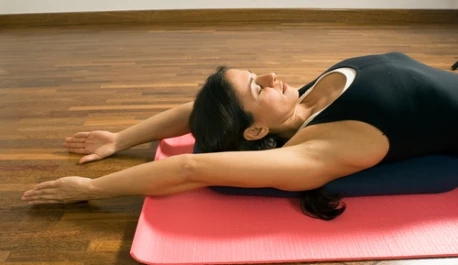Yoga May Help to Relieve The Ongoing Symptoms of Depression

Major depression is the leading cause of disability for those 15 to 44 years of age, and affects nearly 7% of Americans every year. The most common forms of treatment include psychotherapy and medication. A new study suggests that gentle Hatha yoga may help to curb some of the major symptoms of depression.
A group of researchers in Virginia randomly assigned adult women with depression to either a yoga or a health education training control group, then examined change among a number of indicators of depression after 8 weeks and one year later. Both groups reported a decrease in depressive symptoms after 8 weeks of training. Yoga group participants also suggested a trend toward less rumination and feelings of greater social connectedness.
Unfortunately too few control group participants completed the 1-year follow-up to gather sufficient statistical data to look at long-term effects of yoga practice on symptoms of depression. However, interviews with some of the yoga group participants revealed 2 major themes:
-
The importance of acquiring skills for managing depression and stress such as breathing, centering, relaxation, movement, and techniques for dealing with rumination.
-
The need for programs to address barriers to sustained practice including lack of time and motivation, access and financial concerns.
The primary goal of the study was to assess the feasibility of a gentle yoga program for women with depression. Participants were required to be adult women with a confirmed diagnosis of Major Depressive Disorder or Dysthymia. Individuals with psychosis or mania, suicidal tendencies, recent changes in medication, physical conditions limiting their ability to practice yoga, recent surgery or hospitalization, an existing regular yoga or meditation practice, or non-English speakers were excluded from the study. Women were asked to continue with their regular medication and psychotherapy treatments.
Twenty-seven women (15 yoga group and 12 controls) with an average age of 43.3 years (SD = 15.57) enrolled in the study. Approximately two thirds of the sample was white and college educated.
Women in the yoga group were asked to participate in 8, weekly, 75-minute yoga classes. Classes were performed in accordance with a manual to assure their consistency. Practices were “borrowed from multiple gentle styles of yoga” including gentle Hatha, Iyengar, Kripalu and Life Force. They were designed around themes such as “self-care, finding balance and mindfulness” and included the following components:
-
Creating of a safe space and empowerment,
-
Intention setting around a weekly theme,
-
Yogic breathing exercises (Pranayama) with an emphasis on “inducing calm, well-being, stress tolerance and mental focus.”
-
Physical postures (Asana),
-
“Guided meditation” (Yoga Nidra), and
-
“Relaxation” (Savasana).
Participants were also provided a DVD with multiple, 10-minute segments, and handouts with themes, pictures and a description of each week’s practice, and asked to complete 20 minutes of home practice each day.
Women assigned to the health and wellness group were asked to attend a 75-minute group class each week for 8 weeks. The classes were offered by registered nurses, and included lectures and videos around a number of health-related themes.
Participants in both groups completed questionnaires regarding depression severity, stress, anxiety, rumination, and interpersonal sensitivity and hostility. Women in both groups were also interviewed regarding their experience with the classes.
Twelve yoga group members (80%) and 6 control group members (50%) completed the intervention and post-program data collection. Women in both groups attended 6.9 classes on average, and roughly 40-50% completed the recommended dosage of home yoga practice. Only 7 yoga (47%) and 2 control (17%) group participants completed the 1-year follow-up, severely limiting any claims regarding 1-year outcomes.
Participants in both the yoga and health education groups reported decreases in depression scores over time. These decreases did not differ between groups, however. Women in the yoga group reported slightly lower rumination scores at the end of the study compared to controls. There were no differences in anxiety, stress or interpersonal/hostility between the groups after 8 weeks. As mentioned above, an insufficient number of women completed the 1-year follow-up to make any meaningful assumptions about long-term effects.
Some of the most interesting data from this study comes from the semi-structured interviews and participants’ daily logs. An examination of these sources revealed several interesting topics for consideration for future program development and research.
-
Scheduling issues and conflicts with life responsibilities can become barriers to participation as well as a major source of stress for participants. Consequently it is important to emphasize the effort more than the outcome.
-
Participants in both groups benefitted from a structured activity that involved a social component.
-
Women in the health promotion group emphasized increased motivation to care for themselves as a function of the program, whereas those in the yoga group cited strategies for coping with stress and negative self-thoughts as being particularly beneficial in addition to social support.
-
Some but not all participants found the DVDs, class handouts and daily logs to be motivators for practice. A number of participants reported that practice logs “triggered a sense of guilt.” The most consistent answer was that participants felt better after practice, which motivated them to continue with the program.
As with much of yoga research, issues of participant retention during and after a program are a key concern, as is evident in this study. Greater attention needs to be paid to creating feasible programs that meet individuals where they are in terms of their physical, emotional and psychological capacities, and pragmatic and financial realities.
In the case of individuals with depression, it is important to consider how mood, motivation and guilt may deter participants from attending as well as the important influence of social support, timing and dosage when designing programs for those suffering from depressive symptoms.
 Grace Bullock, PhD, E-RYT 500 is a psychologist, research scientist, educator, author, yoga and mindfulness expert and creator of BREATHE: 7 Skills for Mindful Relationships. Her mission is to reduce stress, increase health and wellbeing and improve the quality of relationships. She offers classes, workshops, writing and research that combine the wisdom of applied neuroscience, psychophysiology, psychology and contemplative science and practice. Her goal is to empower individuals, groups, leaders and organizations to reduce chronic stress and increase awareness, attention, compassion, mindfulness and effective communication to strengthen relationships, release dysfunctional patterns and unlock new and healthy ways of being. Dr. Bullock is a Certified Viniyoga Therapist and Faculty at the Integrated Health Yoga Therapy (IHYT) Training program. She is the former Senior Research Scientist at the Mind & Life Institute and former Editor-in-Chief of the International Journal of Yoga Therapy. For more information see www.bgracebullock.com
Grace Bullock, PhD, E-RYT 500 is a psychologist, research scientist, educator, author, yoga and mindfulness expert and creator of BREATHE: 7 Skills for Mindful Relationships. Her mission is to reduce stress, increase health and wellbeing and improve the quality of relationships. She offers classes, workshops, writing and research that combine the wisdom of applied neuroscience, psychophysiology, psychology and contemplative science and practice. Her goal is to empower individuals, groups, leaders and organizations to reduce chronic stress and increase awareness, attention, compassion, mindfulness and effective communication to strengthen relationships, release dysfunctional patterns and unlock new and healthy ways of being. Dr. Bullock is a Certified Viniyoga Therapist and Faculty at the Integrated Health Yoga Therapy (IHYT) Training program. She is the former Senior Research Scientist at the Mind & Life Institute and former Editor-in-Chief of the International Journal of Yoga Therapy. For more information see www.bgracebullock.com
Sources
Kinser, P.A., Bourguignon, C., Whaley, D., Hauenstein, E. & Gill Taylor, A. (2013). Feasibility, Acceptability, and Effects of Gentle Hatha Yoga for Women With Depression: Findings From a Randomized Controlled Mixed-Methods Study. Archives of Psychiatric Nursing, 27, 137-147.
Kinser, P.A., Elswick., R.K. & Kornstein, S. (2014). Potential Long-Term Effects of Mind-Body Intervention for Women with Major Depressive Disorder: Sustained Mental Health improvements with a Pilot Yoga Intervention. Archives of Psychiatric Nursing, 28, 377-383.



